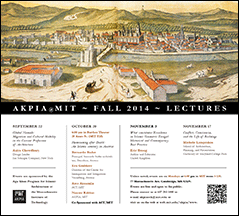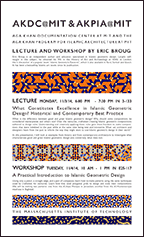Homecoming after Death: An Islamic Cemetery in Austria
Abstract
Can an Islamic cemetery be more than a burial ground for Muslims in the West? This multidisciplinary panel discusses the many ways in which Islamic funerary architecture can contribute to nurturing pluralism in places where Muslims are a minority. Focused on the Islamic cemetery Altach in Austria, winner of the 2013 Aga Khan Award, the panel brings together four distinguished speakers who will elaborate how a construction of a purposely Islamic cemetery may give shape to the process of cultural plurlization and the stablishing of Islamic community in Europe. Funerary architecture, more than any other form of religious architecture, ties the collective memory of a group to a specific territory on an emotional and cultural level.
Bernardo Bader Bio
Bernardo Bader is an architect from Krumbach, the Austrian region of Bregenzerwald, with an office currently in Dornbirn, Austria. He studied architecture at the Innsbruck Technical University and, after receiving his engineering degree (Dipl. Ing.) in 2001, he founded his own architectural office. His work investigates how architecture can be embedded in regional building culture, based on local architectural grammar. His projects bear witness to the excellence of handcraft, deep attention to tectonic detail and sensitivity to the local context. Bader is a member of the Advisory Design Commissions as well as the Advisory Committee for Urban Contemplation in the Vorarlberg region. Since 2012, he has held a lecturing position at the University of Liechtenstein in Vaduz. He has receivedma number of prestigious awards, including the Weissenhof Architectural Furtherance Prize 2007 for young architects in Stuttgart, Germany, the Constructive – Liechtenstein Prize for sustainable building in 2011, the Piranesi Award 2013, and numerous local timber construction awards, as well as clients’ awards. His work was nominated for the DETAIL Prize 2012 and the Mies van der Rohe Award 2013.
Eric Broug
What Constitutes Excellence in Islamic Geometric Design? Historical and Contemporary Best Practice
Abstract
What is the difference between good and great Islamic geometric design? Why should some compositions be considered masterpieces and others not? Over the centuries, craftsmen creating Islamic geometric compositions adhered to design rules. Understanding and creatively applying these rules gave them freedom to make compositions that were indebted to the past while at the same time being new and innovative. What can architects and designers learn from the past to inform the way they might want to use Islamic geometric design in their work?
In this presentation, I will look at examples from history and from contemporary architecture to investigate what characterises good and great Islamic geometric design and, conversely, what does not.
Bio
Eric Broug is an independent author and educator, specialised in Islamic geometric design. Largely self-taught in this subject, he obtained his MA in the History of Art and Archaeology at SOAS in London.
He is the author of a popular book “Islamic Geometric Patterns”, which is also available in Farsi, Turkish and Dutch. It has been a bestselling Islamic art books since its publication. His most recent book “Islamic Geometric Design” (Thames &Hudson) is a large art book with over 800 illustrations, and has also been published in French “l’Art des Motifs Islamiques”.
Eric manages a dynamic social media community dedicated to Islamic art (www.facebook.com/groups/islamicgeometricdesign/) and has created a number of video tutorials on how to draw Islamic geometric patterns . He is currently working on a new book on Islamic geometric design for Thames & Hudson and is involved in several collaborative design projects. He has recently set up the Alhambra Foundation in the UK, dedicated to Islamic geometric design education.
Michele Lamprakos
Conflict, Convivencia, and the Life of Buildings
Abstract
Most scholars know the Great Mosque of Cordoba as one of the great monuments of Islamic civilization. But for almost eight centuries, it has been the Cathedral of Cordoba. Unlike other mosques on the Iberian peninsula, which were demolished and replaced by churches at some point after the Christian conquest, the Great Mosque of Cordoba survived. It was progressively adapted for Catholic worship with relatively minor changes to the fabric. Then, in the early 16th century, a strange thing happened: a Gothic cathedral began to rise from the middle of the building. The massive structure took almost two centuries to complete; protruding from the roof, it transformed both the interior space and the image of the building on the skyline. But the surrounding fabric of the mosque was left more or less intact. This produced a curious dual reading of the building, which has alternately confused, disturbed and fascinated those who visit it and study it. Over the course of the next two centuries, the mosque-cathedral was progressively “christianized” – only to be “re-islamicized” in the 19th-20th centuries, in the era of Romanticism and Liberalism. The Church’s current attempt to tighten its hold, and the resistance this has provoked among secular groups, is just the latest episode in a remarkable 800-year story. The struggle over the fabric and interpretation of the building attests to the continuing power of the Islamic architectural legacy. But it is also a barometer of changing attitudes toward the Islamic past – and the meaning of that past for Spanish culture and society.
Bio
Michele Lamprakos teaches at the School of Architecture, Planning and Preservation at the University of Maryland-College Park. Trained as an architect and an historian, she is interested in the historical layers of buildings and cities, and their transformation in the present. Michele’s career has combined teaching, research, and practice in architecture and preservation. Her forthcoming book, Building a World Heritage City: Sana’a Yemen, is based on her PhD dissertation at MIT (HTC/AKPIA 2006).

